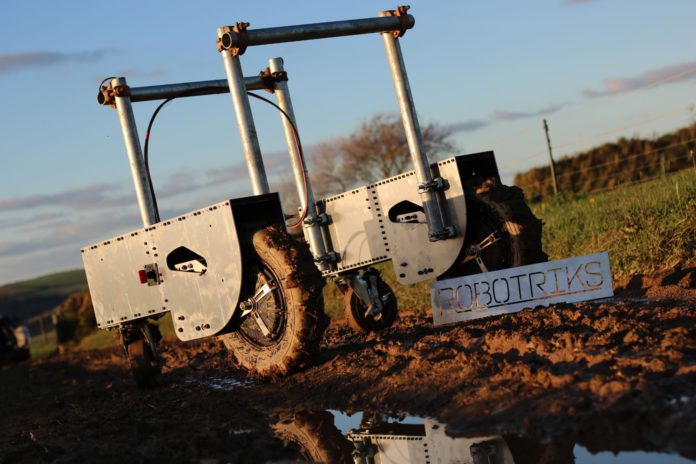Farmers can fit a new low-cost robotic platform to almost any agricultural implement to overcome the lack of available manual labour.
The Robotriks Traction Unit (RTU), created by start-up company Robotriks, costs £7,000.
Powered by batteries which last for 24 hours, it can be built within a few hours. It is made available for a range of tasks from crop monitoring to harvesting crops.
Jake Shaw-Sutton, senior robotics technician at the University of Plymouth and Khaian Marsh co-founded Robotriks, based near St Austell, Cornwall.
Both grew up on farms, so were aware of challenges facing the sector. They could also put the RTU through its paces in real-life situations, including testing for soil compaction.
Robotics to fill labour gap
Mr Shaw-Sutton, an MEng (Hons) Robotics graduate, said: “This is not about taking away jobs. It’s about filling jobs where there currently are no people available to do them.”
“For a while, there have been fewer people willing to go out into the fields and harvest fruit and vegetables; this is an autonomous solution to that, and one which is affordable and reliable.”
“Even with the current cost of the unit, which we’re always trying to improve, it still works out cheaper than having someone employed on minimum wage. It can work for more hours, not needing lunch breaks or sleep at night.”
Robotriks Traction Unit – How does it work?
The RTU works either by remote control or autonomously and comprises a large drive wheel, suspension and a computer system, held together by galvanised pipe – on which farmers can attach pretty much any implement.
The parts are all mass-produced rather than specialist, which brings the costs down. For example, the wheel’s brushless hub motor is from an electric bike.
It then has three control options. The first uses a remote control to drive the unit to a location, mark it as a point, drive to the next position and mark another point. Then, it will keep driving between those points.
The second uses an online map, which appears on a display with the current location, and the operator can click where they want to send the unit, and it will go there.
The third, which is still under development, features full autonomous control using a positioning system known as Real-Time Kinematic (RTK) and drones.
The unit can carry several hundred kilos. It is limited to run at up to 10mph, matching walking or running pace. Also, there are emergency stop buttons on the unit with a remote kill switch.
Mr Shaw-Sutton added: “The unit is fully adjustable to any height and width. Some farms may have narrow paths, for example in fruit and vegetables, or it might need to go wider to get over tall crops.”
“And currently you just plug in to charge it, but we are considering having a docking station because all of the power can be harvested from a single solar panel.”
“While the RTU is still in the testing phase, it is being offered commercially to researchers. We hope it will have enough functionality to offer to a wider market over the next year,” he concluded.





